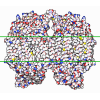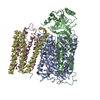[English] 日本語
 Yorodumi
Yorodumi- PDB-8qqk: Cryo-EM structure of E. coli cytochrome bo3 quinol oxidase assemb... -
+ Open data
Open data
- Basic information
Basic information
| Entry | Database: PDB / ID: 8qqk | ||||||||||||
|---|---|---|---|---|---|---|---|---|---|---|---|---|---|
| Title | Cryo-EM structure of E. coli cytochrome bo3 quinol oxidase assembled in peptidiscs | ||||||||||||
 Components Components | (Cytochrome bo(3) ubiquinol oxidase subunit ...) x 4 | ||||||||||||
 Keywords Keywords |  MEMBRANE PROTEIN / MEMBRANE PROTEIN /  E. coli / Ni-NTA resin / cytochrome bo3 quinol oxidase / ubiquinone-8 release / peptidisc / E. coli / Ni-NTA resin / cytochrome bo3 quinol oxidase / ubiquinone-8 release / peptidisc /  single particle analysis / single particle analysis /  cryo-EM cryo-EM | ||||||||||||
| Function / homology |  Function and homology information Function and homology informationcytochrome o ubiquinol oxidase complex / oxidoreduction-driven active transmembrane transporter activity /  ubiquinol oxidase (H+-transporting) / cytochrome bo3 ubiquinol oxidase activity / aerobic electron transport chain / oxidoreductase activity, acting on diphenols and related substances as donors, oxygen as acceptor / ubiquinol oxidase (H+-transporting) / cytochrome bo3 ubiquinol oxidase activity / aerobic electron transport chain / oxidoreductase activity, acting on diphenols and related substances as donors, oxygen as acceptor /  cytochrome-c oxidase activity / cytochrome-c oxidase activity /  ubiquinone binding / electron transport coupled proton transport / proton transmembrane transporter activity ...cytochrome o ubiquinol oxidase complex / oxidoreduction-driven active transmembrane transporter activity / ubiquinone binding / electron transport coupled proton transport / proton transmembrane transporter activity ...cytochrome o ubiquinol oxidase complex / oxidoreduction-driven active transmembrane transporter activity /  ubiquinol oxidase (H+-transporting) / cytochrome bo3 ubiquinol oxidase activity / aerobic electron transport chain / oxidoreductase activity, acting on diphenols and related substances as donors, oxygen as acceptor / ubiquinol oxidase (H+-transporting) / cytochrome bo3 ubiquinol oxidase activity / aerobic electron transport chain / oxidoreductase activity, acting on diphenols and related substances as donors, oxygen as acceptor /  cytochrome-c oxidase activity / cytochrome-c oxidase activity /  ubiquinone binding / electron transport coupled proton transport / proton transmembrane transporter activity / ATP synthesis coupled electron transport / ubiquinone binding / electron transport coupled proton transport / proton transmembrane transporter activity / ATP synthesis coupled electron transport /  respirasome / respirasome /  aerobic respiration / respiratory electron transport chain / aerobic respiration / respiratory electron transport chain /  electron transfer activity / copper ion binding / electron transfer activity / copper ion binding /  heme binding / heme binding /  plasma membrane plasma membraneSimilarity search - Function | ||||||||||||
| Biological species |   Escherichia coli BL21 (bacteria) Escherichia coli BL21 (bacteria) | ||||||||||||
| Method |  ELECTRON MICROSCOPY / ELECTRON MICROSCOPY /  single particle reconstruction / single particle reconstruction /  cryo EM / Resolution: 2.8 Å cryo EM / Resolution: 2.8 Å | ||||||||||||
 Authors Authors | Gao, Y. / Zhang, Y. / Hakke, S. / Peters, P.J. / Ravelli, R.B.G. | ||||||||||||
| Funding support |  Netherlands, 3items Netherlands, 3items
| ||||||||||||
 Citation Citation |  Journal: Biochim Biophys Acta Bioenerg / Year: 2024 Journal: Biochim Biophys Acta Bioenerg / Year: 2024Title: Cryo-EM structure of cytochrome bo quinol oxidase assembled in peptidiscs reveals an "open" conformation for potential ubiquinone-8 release. Authors: Ye Gao / Yue Zhang / Sneha Hakke / Ronny Mohren / Lyanne J P M Sijbers / Peter J Peters / Raimond B G Ravelli /  Abstract: Cytochrome bo quinol oxidase belongs to the heme‑copper-oxidoreductase (HCO) superfamily, which is part of the respiratory chain and essential for cell survival. While the reaction mechanism of cyt ...Cytochrome bo quinol oxidase belongs to the heme‑copper-oxidoreductase (HCO) superfamily, which is part of the respiratory chain and essential for cell survival. While the reaction mechanism of cyt bo has been studied extensively over the last decades, specific details about its substrate binding and product release have remained unelucidated due to the lack of structural information. Here, we report a 2.8 Å cryo-electron microscopy structure of cyt bo from Escherichia coli assembled in peptidiscs. Our structural model shows a conformation for amino acids 1-41 of subunit I different from all previously published structures while the remaining parts of this enzyme are similar. Our new conformation shows a "U-shape" assembly in contrast to the transmembrane helix, named "TM0", in other reported structural models. However, TM0 blocks ubiquinone-8 (reaction product) release, suggesting that other cyt bo conformations should exist. Our structural model presents experimental evidence for an "open" conformation to facilitate substrate/product exchange. This work helps further understand the reaction cycle of this oxidase, which could be a benefit for potential drug/antibiotic design for health science. | ||||||||||||
| History |
|
- Structure visualization
Structure visualization
| Structure viewer | Molecule:  Molmil Molmil Jmol/JSmol Jmol/JSmol |
|---|
- Downloads & links
Downloads & links
- Download
Download
| PDBx/mmCIF format |  8qqk.cif.gz 8qqk.cif.gz | 236.6 KB | Display |  PDBx/mmCIF format PDBx/mmCIF format |
|---|---|---|---|---|
| PDB format |  pdb8qqk.ent.gz pdb8qqk.ent.gz | 182.5 KB | Display |  PDB format PDB format |
| PDBx/mmJSON format |  8qqk.json.gz 8qqk.json.gz | Tree view |  PDBx/mmJSON format PDBx/mmJSON format | |
| Others |  Other downloads Other downloads |
-Validation report
| Arichive directory |  https://data.pdbj.org/pub/pdb/validation_reports/qq/8qqk https://data.pdbj.org/pub/pdb/validation_reports/qq/8qqk ftp://data.pdbj.org/pub/pdb/validation_reports/qq/8qqk ftp://data.pdbj.org/pub/pdb/validation_reports/qq/8qqk | HTTPS FTP |
|---|
-Related structure data
| Related structure data |  18594MC M: map data used to model this data C: citing same article ( |
|---|---|
| Similar structure data | Similarity search - Function & homology  F&H Search F&H Search |
- Links
Links
- Assembly
Assembly
| Deposited unit | 
|
|---|---|
| 1 |
|
- Components
Components
-Cytochrome bo(3) ubiquinol oxidase subunit ... , 4 types, 4 molecules ABCD
| #1: Protein | Mass: 74424.469 Da / Num. of mol.: 1 / Source method: isolated from a natural source / Source: (natural)   Escherichia coli BL21(DE3) (bacteria) / Variant: C41 Escherichia coli BL21(DE3) (bacteria) / Variant: C41References: UniProt: P0ABI8,  ubiquinol oxidase (H+-transporting) ubiquinol oxidase (H+-transporting) |
|---|---|
| #2: Protein | Mass: 34947.203 Da / Num. of mol.: 1 / Source method: isolated from a natural source / Source: (natural)   Escherichia coli BL21(DE3) (bacteria) / Variant: C41 / References: UniProt: P0ABJ1 Escherichia coli BL21(DE3) (bacteria) / Variant: C41 / References: UniProt: P0ABJ1 |
| #3: Protein | Mass: 22642.566 Da / Num. of mol.: 1 / Source method: isolated from a natural source / Source: (natural)   Escherichia coli BL21(DE3) (bacteria) / Variant: C41 / References: UniProt: P0ABJ3 Escherichia coli BL21(DE3) (bacteria) / Variant: C41 / References: UniProt: P0ABJ3 |
| #4: Protein | Mass: 12037.402 Da / Num. of mol.: 1 / Source method: isolated from a natural source / Source: (natural)   Escherichia coli BL21(DE3) (bacteria) / Variant: C41 / References: UniProt: P0ABJ6 Escherichia coli BL21(DE3) (bacteria) / Variant: C41 / References: UniProt: P0ABJ6 |
-Non-polymers , 5 types, 9 molecules 
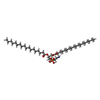

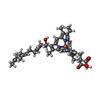
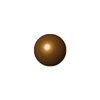




| #5: Chemical |  POPC POPC#6: Chemical |  Phosphatidylethanolamine Phosphatidylethanolamine#7: Chemical | ChemComp-HEM / |  Heme B Heme B#8: Chemical | ChemComp-HEO / |  Heme O Heme O#9: Chemical | ChemComp-CU / |  Copper Copper |
|---|
-Details
| Has ligand of interest | N |
|---|
-Experimental details
-Experiment
| Experiment | Method:  ELECTRON MICROSCOPY ELECTRON MICROSCOPY |
|---|---|
| EM experiment | Aggregation state: PARTICLE / 3D reconstruction method:  single particle reconstruction single particle reconstruction |
- Sample preparation
Sample preparation
| Component | Name: Cytochrome bo3 quinol oxidase / Type: COMPLEX Details: Heme-copper-oxidoreductase purified from E. coli native membranes by Ni-NTA affinity chromatography. Entity ID: #1-#4 / Source: NATURAL | ||||||||||||||||||||
|---|---|---|---|---|---|---|---|---|---|---|---|---|---|---|---|---|---|---|---|---|---|
| Molecular weight | Value: 0.144 MDa / Experimental value: NO | ||||||||||||||||||||
| Source (natural) | Organism:   Escherichia coli (E. coli) / Strain: C41 Escherichia coli (E. coli) / Strain: C41 | ||||||||||||||||||||
| Buffer solution | pH: 8 Details: 20mM Tris-HCL, 150mM NaCl, 2% Glycerol, filtered and degassed. | ||||||||||||||||||||
| Buffer component |
| ||||||||||||||||||||
| Specimen | Conc.: 1.6 mg/ml / Embedding applied: NO / Shadowing applied: NO / Staining applied : NO / Vitrification applied : NO / Vitrification applied : YES : YES | ||||||||||||||||||||
| Specimen support | Grid material: GOLD / Grid mesh size: 300 divisions/in. / Grid type: UltrAuFoil R1.2/1.3 | ||||||||||||||||||||
Vitrification | Instrument: FEI VITROBOT MARK IV / Cryogen name: ETHANE / Humidity: 95 % / Chamber temperature: 277.15 K |
- Electron microscopy imaging
Electron microscopy imaging
| Experimental equipment |  Model: Titan Krios / Image courtesy: FEI Company |
|---|---|
| Microscopy | Model: FEI TITAN KRIOS |
| Electron gun | Electron source : :  FIELD EMISSION GUN / Accelerating voltage: 300 kV / Illumination mode: FLOOD BEAM FIELD EMISSION GUN / Accelerating voltage: 300 kV / Illumination mode: FLOOD BEAM |
| Electron lens | Mode: BRIGHT FIELD Bright-field microscopy / Nominal magnification: 105000 X / Nominal defocus max: 2000 nm / Nominal defocus min: 1500 nm / C2 aperture diameter: 100 µm / Alignment procedure: ZEMLIN TABLEAU Bright-field microscopy / Nominal magnification: 105000 X / Nominal defocus max: 2000 nm / Nominal defocus min: 1500 nm / C2 aperture diameter: 100 µm / Alignment procedure: ZEMLIN TABLEAU |
| Specimen holder | Cryogen: NITROGEN / Specimen holder model: FEI TITAN KRIOS AUTOGRID HOLDER |
| Image recording | Average exposure time: 2.1 sec. / Electron dose: 50 e/Å2 / Film or detector model: GATAN K3 BIOQUANTUM (6k x 4k) / Num. of grids imaged: 1 / Num. of real images: 8050 |
| Image scans | Sampling size: 5 µm / Width: 5760 / Height: 4092 |
- Processing
Processing
| EM software |
| ||||||||||||||||||||||||||||||
|---|---|---|---|---|---|---|---|---|---|---|---|---|---|---|---|---|---|---|---|---|---|---|---|---|---|---|---|---|---|---|---|
CTF correction | Type: PHASE FLIPPING AND AMPLITUDE CORRECTION | ||||||||||||||||||||||||||||||
| Particle selection | Num. of particles selected: 1277595 | ||||||||||||||||||||||||||||||
| Symmetry | Point symmetry : C1 (asymmetric) : C1 (asymmetric) | ||||||||||||||||||||||||||||||
3D reconstruction | Resolution: 2.8 Å / Resolution method: FSC 0.143 CUT-OFF / Num. of particles: 45014 / Algorithm: FOURIER SPACE / Num. of class averages: 1 / Symmetry type: POINT | ||||||||||||||||||||||||||||||
| Atomic model building | B value: 59.97 / Protocol: FLEXIBLE FIT / Space: REAL | ||||||||||||||||||||||||||||||
| Atomic model building | PDB-ID: 1FFT Accession code: 1FFT / Source name: PDB / Type: experimental model | ||||||||||||||||||||||||||||||
| Refine LS restraints |
|
 Movie
Movie Controller
Controller


 PDBj
PDBj